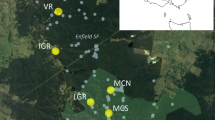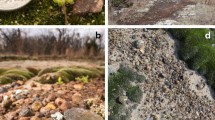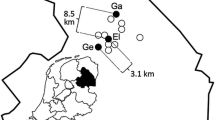Abstract
Conservation of species threatened by habitat fragmentation is a major global challenge, and determining the genetic and demographic processes associated with isolation and reductions in population size will be critical for an increasing number of species. We conducted controlled crosses and field germination experiments to quantify the effects of inbreeding and outbreeding in the declining orchid Gymnadenia conopsea in two Norwegian populations that differ in size. We further compared our results with published estimates of inbreeding depression in orchids. There was severe inbreeding depression for seed production (δ = 0.41–0.67) and germination (δ = 0.46–0.66) in both populations, with stronger inbreeding depression in the large population. Compared to outcrossing, selfing reduced female fitness (number of seeds per fruit × proportion of seeds germinating) by 76 and 54 % in the large and small population, respectively. The magnitude of inbreeding depression for seed production was higher than the average reported for orchids, while for germination it was similar to earlier estimates. The large population also experienced considerable outbreeding depression for seed production (δ = 0.23–0.27), germination (δ = 0.33) and female fitness (δ = 0.47) following crosses with a population 1.6 km away. The strong inbreeding depression indicates that both populations harbour a substantial genetic load, and suggests that fragmentation may reinforce population decline in G. conopsea via increased inbreeding. Moreover, the local outbreeding depression indicates substantial genetic differentiation at a moderate spatial scale. This has important implications for the use of crosses between populations or plant translocations as conservation approaches.


Similar content being viewed by others
References
Ågren J, Schemske DW (1993) Outcrossing rate and inbreeding depression in two annual monoecious herbs, Begonia hirsuta and B. semiovata. Evolution 47:125–135
Aguilar R, Ashworth L, Galetto L, Aizen MA (2006) Plant reproductive susceptibility to habitat fragmentation: review and synthesis through a meta-analysis. Ecol Lett 9:968–980
Alexandersson R, Ågren J (2000) Genetic structure in the nonrewarding, bumblebee-pollinated orchid Calypso bulbosa. Heredity 85:401–409
Angeloni F, Ouborg NJ, Leimu R (2011) Meta-analysis on the association of population size and life history with inbreeding depression in plants. Biol Conserv 144:35–43
Arditti J, Ghani AKA (2000) Numerical and physical properties of orchid seeds and their biological implications. New Phytol 145:367–421
Barrett SCH, Harder LD, Cole WW (1994) Effects of flower number and position on self-fertilization in experimental populations of Eichhornia paniculata (Pontederiaceae). Funct Ecol 8:526–535
Bellusci F, Pellegrino G, Musacchio A (2009) Different levels of inbreeding depression between outcrossing and selfing Serapias species. Biol Plant 53:175–178
Campbell VV, Rowe G, Beebee TJC, Hutchings MJ (2007) Genetic differentiation amongst fragrant orchids (Gymnadenia conopsea s.l.) in the British Isles. Bot J Linn Soc 155:349–360
Charlesworth D, Charlesworth B (1987) Inbreeding depression and its evolutionary consequences. Annu Rev Ecol Syst 18:237–268
Charlesworth D, Willis JH (2009) The genetics of inbreeding depression. Nat Rev Genet 10:783–796
Cheptou P-O, Donohue K (2011) Environment-dependent inbreeding depression: its ecological and evolutionary significance. New Phytol 189:395–407
Chung MY, Nason JD, Chung MG (2004) Spatial genetic structure in populations of the terrestrial orchid Cephalanthera longibracteata (Orchidaceae). Am J Bot 91:52–57
Darwin C (1862) On the various contrivances by which British and foreign orchids are fertilised by insects. John Murray, London
Dierks A, Baumann B, Fischer K (2012) Response to selection on cold tolerance is constrained by inbreeding. Evolution. doi:10.1111/j.1558-5646.2012.01604.x
Dudash MR, Fenster CB (2000) Inbreeding and outbreeding depression in fragmented populations. In: Young AG, Clarke GM (eds) Genetics, demography and viability of fragmented populations. Cambridge University Press, Cambridge, pp 35–53
Eckert CG et al (2010) Plant mating systems in a changing world. Trends Ecol Evol 25:35–43
Ellstrand NC, Elam DR (1993) Population genetic consequences of small population size: implications for plant conservation. Annu Rev Ecol Syst 24:217–242
Epinat G, Lenormand T (2009) The evolution of assortative mating and selfing with in- and outbreeding depression. Evolution 63:2047–2060
Ferdy JB, Loriot S, Sandmeier M, Lefranc M, Raquin C (2001) Inbreeding depression in a rare deceptive orchid. Can J Bot 79:1181–1188
Franco M, Silvertown J (2004) Comparative demography of plants based upon elasticities of vital rates. Ecology 85:531–538
Goverde M, Schweizer K, Baur B, Erhardt A (2002) Small-scale habitat fragmentation effects on pollinator behaviour: experimental evidence from the bumblebee Bombus veteranus on calcareous grasslands. Biol Conserv 104:293–299
Grindeland JM (2008) Inbreeding depression and outbreeding depression in Digitalis purpurea: optimal outcrossing distance in a tetraploid. J Evol Biol 21:716–726
Grindeland JM, Sletvold N, Ims RA (2005) Effects of floral display size and plant density on pollinator visitation rate in a natural population of Digitalis purpurea. Funct Ecol 19:383–390
Gustafsson S (2000) Patterns of genetic variation in Gymnadenia conopsea, the fragrant orchid. Mol Ecol 9:1863–1872
Gustafsson S, Sjögren-Gulve P (2002) Genetic diversity in the rare orchid, Gymnadenia odoratissima and a comparison with the more common congener, G. conopsea. Conserv Genet 3:225–234
Husband BC, Schemske DW (1996) Evolution and timing of inbreeding depression in plants. Evolution 50:54–70
Ingvarsson PK (2001) Restoration of genetic variation lost—the genetic rescue hypothesis. Trends Ecol Evol 16:62–63
Jacquemyn H, Brys R, Hermy M, Willems JH (2007) Long-term dynamics and population viability in one of the last populations of the endangered Spiranthes spiralis (Orchidaceae) in The Netherlands. Biol Conserv 134:14–21
Jacquemyn H, Wiegand T, Vandepitte K, Brys R, Roldán-Ruiz I, Honnay O (2009) Multigenerational analysis of spatial structure in the terrestrial, food-deceptive orchid Orchis mascula. J Ecol 97:206–216
Jacquemyn H, Brys R, Jongejans E (2010) Seed limitation restricts population growth in shaded populations of a perennial woodland orchid. Ecology 91:119–121
Jersáková J, Malinová T (2007) Spatial aspects of seed dispersal and seedling recruitment in orchids. New Phytol 176:237–241
Jersáková J, Johnson SD, Kindlmann P (2006) Mechanisms and evolution of deceptive pollination in orchids. Biol Rev 81:219–235
Johnson SD, Peter CI, Ågren J (2004) The effects of nectar addition on pollen removal and geitonogamy in the non-rewarding orchid Anacamptis morio. Proc R Soc B 271:803–809
Johnson SD, Neal PR, Harder LD (2005) Pollen fates and the limits on male reproductive success in an orchid population. Biol J Linn Soc 86:175–190
Johnson SD, Torninger E, Ågren J (2009) Relationships between population size and pollen fates in a moth-pollinated orchid. Biol Lett 5:282–285
Juillet N, Dunand-Martin S, Gigord LDB (2007) Evidence for inbreeding depression in the food-deceptive colour-dimorphic orchid Dactylorhiza sambucina (L.) Soò. Plant Biol 9:147–151
Kålås JA, Viken Å, Henriksen S, Skjelseth S (eds) (2010) The 2010 Norwegian Red List for species. Norwegian Biodiversity Information Centre, Trondheim
Kearns CA, Inouye DW (1993) Techniques for pollination biologists. University Press of Colorado, Niwot
Klank C, Pleuss AR, Ghazoul J (2010) Effects of population size on plant reproduction and pollinator abundance in a specialized pollination system. J Ecol 98:1389–1397
Kolb A (2008) Habitat fragmentation reduces plant fitness by disturbing pollination and modifying response to herbivory. Biol Conserv 141:2540–2549
Kull T, Hutchings MJ (2006) A comparative analysis of decline in the distribution ranges of orchid species in Estonia and the United Kingdom. Biol Conserv 129:31–39
Lammi A, Vallius E, Vauhkonen T, Kuitunen M (2003) Outcrossing, hybridization, pollen quantity, and the evolution of deceptive pollination in Dactylorhiza incarnata. Ann Bot Fenn 40:331–338
Lande R (1988) Genetics and demography in biological conservation. Science 241:1455–1460
Lennartsson T (2002) Extinction thresholds and disrupted plant–pollinator interactions in fragmented plant populations. Ecology 83:3060–3072
Lienert J (2004) Habitat fragmentation effects on fitness of plant populations—a review. J Nat Conserv 12:53–72
Linhart YB, Grant MC (1996) Evolutionary significance of local genetic differentiation in plants. Annu Rev Ecol Syst 27:237–277
Machon N, Bardin P, Mazer SJ, Moret J, Godelle B, Austerlitz F (2003) Relationship between genetic structure and seed and pollen dispersal in the endangered orchid Spiranthes spiralis. New Phytol 157:677–687
McCall C, Mitchell-Olds T, Waller DM (1991) Distance between mates affects seedling characters in a population of Impatiens capensis (Balsaminaceae). Am J Bot 78:964–970
Oostermeijer JGB, Luijten SH, den Nijs JCM (2003) Integrating demographic and genetic approaches in plant conservation. Biol Conserv 113:389–398
Ouborg NJ (2010) Integrating population genetics and conservation biology in the era of genomics. Biol Lett 6:3–6
Peakall R, Beattie AJ (1996) Ecological and genetic consequences of pollination by sexual deception in the orchid Caladenia tentaculata. Evolution 50:2207–2220
Primack R (2006) Essentials of conservation biology, 4th edn. Sinauer Associates, Sunderland
Quilichini A, Debussche M, Thompson JD (2001) Evidence for local outbreeding depression in the Mediterranean island endemic Anchusa crispa Viv. (Boraginaceae). Heredity 87:190–197
Raijmann LEL, van Leuwen NC, Kersten R, Oostermeijer JGB, den Nijs HCM, Menken SBJ (1994) Genetic variation and outcrossing rate in relation to population size in Gentiana pneumonanthe L. Conserv Biol 8:1014–1026
Rasmussen HN, Whigham DF (1993) Seed ecology of dust seeds in-situ—a new study technique and its application in terrestrial orchids. Am J Bot 80:1374–1378
Ritland K, Ganders FR (1987) Crossability of Mimulus guttatus in relation to components of gene fixation. Evolution 41:772–786
Rusterholz H-P, Baur B (2010) Delayed response in a plant–pollinator system to experimental grassland fragmentation. Oecologia 163:141–152
Sletvold N, Ågren J (2010) Pollinator-mediated selection on floral display and spur length in the orchid Gymnadenia conopsea. Int J Plant Sci 171:999–1009
Sletvold N, Ågren J (2011) Among-population variation in costs of reproduction in the long-lived orchid Gymnadenia conopsea: an experimental study. Oecologia 167:461–468
Sletvold N, Øien D-I, Moen A (2010) Long-term influence of mowing on population dynamics in the rare orchid Dactylorhiza lapponica: the importance of recruitment and seed production. Biol Conserv 143:747–755
Sletvold N, Trunschke J, Wimmergren C, Ågren J (2012) Separating selection by diurnal and nocturnal pollinators on floral display and spur length in Gymnadenia conopsea. Ecology. doi:10.1890/11-2044
Smithson A (2006) Pollinator limitation and inbreeding depression in orchid species with and without nectar rewards. New Phytol 169:419–430
Soliva M, Widmer A (1999) Genetic and floral divergence among sympatric populations of Gymnadenia conopsea s.l. (Orchideaceae) with different flowering phenology. Int J Plant Sci 160:897–905
Stark C, Babik W, Durka W (2009) Fungi from the roots of the common terrestrial orchid Gymnadenia conopsea. Mycol Res 113:952–959
Tremblay RL, Ackerman JD, Zimmerman JK, Calvo RN (2005) Variation in sexual reproduction in orchids and its evolutionary consequences: a spasmodic journey to diversification. Biol J Linn Soc 84:1–54
Vekemans X, Hardy OJ (2004) New insights from fine-scale spatial genetic structure analyses in plant populations. Mol Ecol 13:921–935
Vergeer P, Sonderen E, Ouborg NJ (2004) Introduction strategies put to the test: local adaptation versus heterosis. Conserv Biol 18:812–821
Waites AR, Ågren J (2004) Pollinator visitation, stigmatic pollen loads, and among-population variation in seed set in Lythrum salicaria. J Ecol 92:512–526
Waser NM, Price MV (1989) Optimal outcrossing in Ipomopsis aggregata: seed set and offspring fitness. Evolution 43:1097–1109
Weber A, Kolb A (2011) Evolutionary consequences of habitat fragmentation: population size and density affect selection on inflorescence size in a perennial herb. Evol Ecol 25:417–428
Young A, Boyle T, Brown T (1996) The population genetic consequences of habitat fragmentation for plants. Trends Ecol Evol 11:413–418
Acknowledgments
We thank A. Moen, D.-I. Øien and A. Lyngstad for advice and support during fieldwork. Funding from the Norwegian Research Council (NS) and from the Swedish Research Council (JÅ) is acknowledged.
Author information
Authors and Affiliations
Corresponding author
Electronic supplementary material
Below is the link to the electronic supplementary material.
Rights and permissions
About this article
Cite this article
Sletvold, N., Grindeland, J.M., Zu, P. et al. Strong inbreeding depression and local outbreeding depression in the rewarding orchid Gymnadenia conopsea . Conserv Genet 13, 1305–1315 (2012). https://doi.org/10.1007/s10592-012-0373-7
Received:
Accepted:
Published:
Issue Date:
DOI: https://doi.org/10.1007/s10592-012-0373-7




